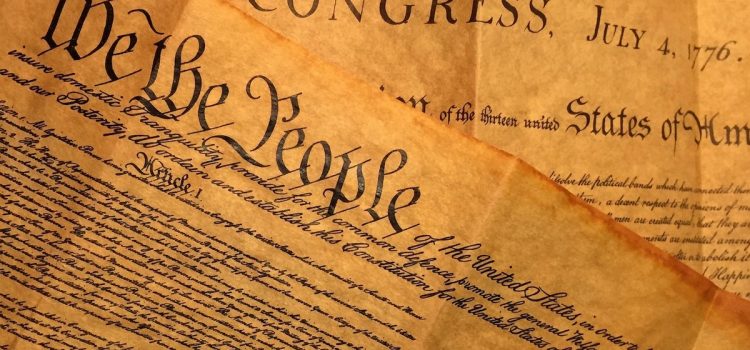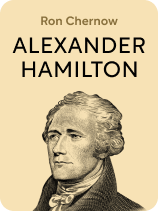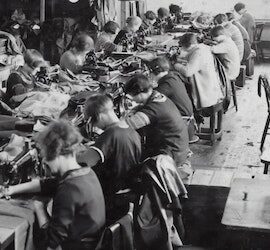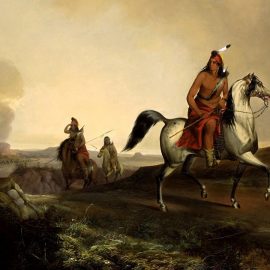

This article is an excerpt from the Shortform book guide to "Alexander Hamilton" by Ron Chernow. Shortform has the world's best summaries and analyses of books you should be reading.
Like this article? Sign up for a free trial here.
How did Alexander Hamilton influence the US Constitution? What part did he play in the Revolutionary War?
Hamilton was one of George Washington’s most trusted allies in the Revolutionary War. As noted in Ron Chernow’s biography of him, this led to Hamilton becoming an admired delegate at the Constitutional Convention.
Continuing reading to learn about the relationship between George Washington and Alexander Hamilton, the Constitution’s beginnings, and post-war reconstruction.
The Revolutionary War and Service With Washington
Before getting into how Alexander Hamilton, the Constitution, and the Federalist Papers play into US history, it’s important to know about Hamilton’s role in the war. War finally broke out between Great Britain and American revolutionaries in the spring of 1775, and Hamilton dropped out of school to join his local volunteer militia. While Hamilton served in several battles, Chernow argues that the most significant event of the war for Hamilton would be his appointment to the staff of General George Washington in 1777. Washington was Commander in Chief of the entire Revolutionary Army and would become the first president of the United States in 1789. His lifelong friendship with Hamilton made the latter’s political career possible, as Hamilton went from being a poor little-known writer to the trusted advisor to the most powerful man in the country.
(Shortform note: In 2016, historians Stephen F. Knott and Tony Williams dedicated an entire book to the Washington-Hamilton relationship, in which they also argued that Hamilton is a central figure to the founding of the US who has been unfairly overlooked. They emphasized the unlikeliness of the two men’s lifelong closeness, since they were over twenty years apart in age, came from totally different economic backgrounds, and apparently had opposite personalities, with Washington being quiet and distant while Hamilton was passionate and social.)
Chernow argues that Washington placed enormous faith in Hamilton, using him not just as a scribe and courier but allowing him to write letters on Washington’s behalf and deliver orders in Washington’s name. When France joined the war on the side of the revolutionaries in 1778, Hamilton acted as Washington’s interpreter, making him even more essential. While the two men had a falling out in 1781, which Chernow believes was over Hamilton’s desire for a military command of his own, they would renew their friendship by the end of the decade. The war also made Hamilton increasingly famous and admired among revolutionaries, as he participated in decisive victories over the British such as the battle of Yorktown.
(Shortform note: Hamilton never visited France, though he spoke the language fluently from a young age. Many Founding Fathers fostered close relationships with the French government both pre- and post-1789 French Revolution, cultivating it as a valuable ally against the still-powerful British Empire. Benjamin Franklin and Thomas Jefferson each lived in France for several years, and one of the heroes of the American Revolution, Gilbert du Motier (better known in the US by his title, the Marquis de Lafayette), was a Frenchman.)
Post-War Restructuring
Having won the war by 1783, the newly independent American government was faced with the problem of developing a functional government in the face of bankruptcy and political unrest. Chernow argues that it was at this time that Hamilton became a significant political figure, most notably as a delegate to the 1787 Constitutional Convention and the primary author of The Federalist Papers, a series of essays defending and explaining the Constitution to the general public.
Though Hamilton did not write the Constitution—Virginia delegate James Madison was its primary author—the final document largely conformed to his vision of what the US government should look like in the coming decades. This meant a strong, centralized power with the authority to unite the entire American population, which at that time was divided into 13 semi-autonomous states.
(Shortform note: The thirteen states began as thirteen colonies, established by Europeans on North American soil beginning in the early 17th century. Though various nations and religious groups were represented in these colonies, including France, The Netherlands, and Christian separatists like the Puritans, by the mid-18th century all of them were under British rule. Because they were founded as independent entities and remained culturally and religiously diverse, many imagined that they would continue to function separately under the new US government. Instead, the Constitution made them participants in a single unified government.)
Hamilton’s Belief in a Strong Central Government
Hamilton was an early proponent of the need for a strong, centralized government at the head of the United States rather than a loose alliance of 13 smaller state governments. Chernow argues that this conviction came out of Hamilton’s experiences in the Revolutionary War, where a lack of Congressional authority or sense of shared identity between soldiers had left the army perpetually lacking in arms, food, and personnel. Taxes intended to fund the war had gone unpaid, state politicians had ignored summons to Congress, and soldiers were poorly trained and frequently deserted.
(Shortform note: The Continental Army was made up of volunteers who enlisted for 1-3 year periods, and it endured a series of crises throughout the war as soldiers agitated for better pay, refused to re-enlist when their term was up, and starved or froze to death due to inadequate supplies. Historians generally agree that the US won the war not because of the strength of its army but because of widespread popular support for independence, French assistance after 1777, and Britain’s mismanagement of their own army.)
Now that the war was over, Hamilton feared that this disorganization and lack of unity might lead to civil war between the states, as larger states with heavy debts attempted to cannibalize smaller, weaker ones. He also feared threats from outside—Spain, France, and Britain had competed for territory and influence in the Americas for centuries, and now that Britain had been forced out, other European powers might take advantage of the chaos and crush the new US government themselves.
| The French and Indian War and Its Consequences A decade before the American Revolution, Britain, France, Spain, and the American colonists were involved in the French and Indian War (typically called the Seven Years War in Europe), which resulted in the British seizure of territory in North America, the Caribbean, Africa, and Southeast Asia. Many US historians suggest that this victory was a catalyst for the American Revolution, as it made George Washington a war hero and led to Britain imposing heavy taxes on the colonists to help pay off its war debt. In addition, some scholars believe that European support for the American Revolution was motivated more by a desire to recoup their losses from the 1760s and weaken British naval power than by admiration for American democracy. |
In writings throughout and following the war, Hamilton argued that the US would have no hope of survival if it did not attempt to unite the entire population under a shared “American” identity, convince the states to accept the authority of a powerful national government for their own safety, impose federal taxes to address the country’s debts, and replace local volunteer militias with the structure of a formal army. Chernow notes that all of these suggestions would find their way into the text of the Constitution, and all but the suggestion of a formal army would be realized in Hamilton’s lifetime.
(Shortform note: The changing attitude toward central government among the Founding Fathers is reflected in the language used in the Constitution versus that of the Declaration of Independence written over a decade earlier. While the Declaration refers to the “separate but equal status” desired by the “Free and Independent States,” the Constitution refers to the need for “uniformity” and equality among the single “We the People of the United States.”)
The Need for a New Constitution
The first step to the formation of the new government was to draft a new constitution. Chernow describes the first constitution, titled the Articles of Confederation and adopted by Congress in 1777, as favoring the states’ independence over the strength of their alliance. In the view of many Founding Fathers, including Hamilton and Madison, this had led to a country doomed to collapse, as evidenced by the seriousness of the problems it faced by the late 1780s.
(Shortform note: The Articles of Confederation was one of three foundational documents written at the Second Continental Congress, the others being the Declaration of Independence and a model treaty. The Articles, written primarily by Delaware politician John Dickinson, emphasized that the US was not a single nation so much as a “perpetual union” between autonomous states, cooperating in a “league of friendship” against their British oppressors. Notably, it was also the first official document to refer to the revolutionary government as the United States of America.)
The main problem was a financial crisis, as the new paper currency was functionally worthless, federal taxes weren’t being collected, and the states all had different, conflicting trade policies. The US had massive outstanding loans to France and the Netherlands for the assistance they’d provided during the war, and many of the revolutionary soldiers had gone years without pay. The end of trade with Britain also meant a shortage of consumer goods.
(Shortform note: The failure of paper money, called Continental dollars, was due to a variety of factors—Congress printed too much of it, leading to rapid inflation; states continued to issue their own currency and the exchange rates were not fixed; and the British introduced thousands of counterfeit bills into the American economy during the war, further depreciating its value. By the 1780s, it was popular to refer to something of little value as being “not worth a Continental.”)
These monetary issues led to two attempted uprisings in the early 1780s, which Chernow argues acted as catalysts for the formation of the Constitutional Convention, where the Articles would be revised and ultimately thrown out. In 1783, 400 soldiers marched on Philadelphia to demand back pay and pensions, chasing Congress out of the state for the next several years. In 1786, Massachusetts residents attacked tax officials whom they saw as exploiting their poverty, and they were only barely prevented from further violence by the state militia. Both Hamilton and Washington expressed alarm at these possible signs of counterrevolution.
(Shortform note: Counterrevolution describes a revolution that either opposes or reverses the results of another, earlier revolution. In the period of political turmoil and disorganization that follows a revolution, it’s possible for splinter groups to seize power through violence or by denouncing their former allies as traitors to the movement who can’t be trusted to rule. If a counterrevolution attempt is not immediately successful, it can devolve into civil war, as occurred in Russia in the 1910s-20s and in Spain in the 1930s.)
Ratification and The Federalist Papers
After months of secretive meetings, the delegates of the Constitutional Convention submitted the new Constitution to the states for ratification. This document carefully distinguished between powers exclusive to the federal government, such as the ability to regulate trade, and those shared with the states, such as the ability to impose taxes. It also divided the central government into three branches and described the qualifications and term limits for the members of each branch—the President in the executive branch, Congressmen in the legislative branch, and Justices in the judicial branch.
According to Chernow, the majority of the delegates to the Constitutional Convention shared Hamilton’s vision of a strong central government, though fights were waged over specifics like the balance of power and term limits. The response of the general public to the Constitution, however, was outrage, as this was such a radical break with the Articles’ description of a loose confederacy. The ratification process required nine states to accept the Constitution before it would be adopted, and in the end this process stretched for over a year.
Hamilton began the project of writing The Federalist Papers out of his belief that the Constitution—which, Chernow argues, was so brief that it was open to a number of interpretations—needed to be thoroughly explained and defended to state voters. In 85 essays written with Madison and New York politician John Jay, Hamilton discussed each clause of the Constitution and its applications, emphasizing the limits of federal versus state powers and the spirit of compromise that had gone into writing it. The majority of the essays were written by Hamilton, and Chernow describes it as Hamilton’s best-known and most influential work, still cited in Supreme Court interpretations of constitutionality.

———End of Preview———
Like what you just read? Read the rest of the world's best book summary and analysis of Ron Chernow's "Alexander Hamilton" at Shortform.
Here's what you'll find in our full Alexander Hamilton summary:
- The biography of Alexander Hamilton that was adapted into the Broadway musical
- The life and influence of the overlooked Founding Father
- How Hamilton's life ended in scandal and a fatal duel






